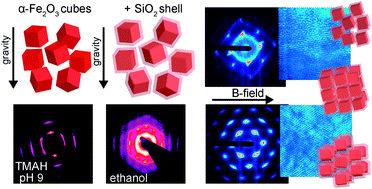Self-assembly of colloidal hematite cubes: a microradian X-ray diffraction exploration of sedimentary crystals†
Abstract
The structure of spontaneously formed crystals in the sediments of colloidal hematite (α-Fe2O3) cubes is studied using microradian X-ray diffraction. The hematite cubes possess a superball shape and a permanent magnetic dipole moment, both influencing the self-assembly behaviour and inducing directionality in different ways. To control the inter-cube interactions, the cubes were dispersed in different solvents and/or coated with a silica layer and allowed to form sediments under the simultaneous effect of the gravitational field and an applied magnetic field. The microradian X-ray diffraction revealed that changing the double layer repulsion that opposes the magnetic and van der Waals attractions can induce short to long-range ordering in the fast sedimenting systems of the cubes. The presence of an external magnetic field during sedimentation induced the formation of a single crystal with long-range order that showed different symmetries, rectangular or hexagonal, close to the fluid–solid interface. The identified 3D crystal structure of both was found to have a body centred monoclinic lattice periodicity that rotates deeper in the sediment due to gravitational compression. This experimental structure differs from the expected crystal lattices determined by simulations and is most likely due to the effects of long-range repulsion and dipole–dipole interactions present here.

- This article is part of the themed collection: Directed self-assembly

 Please wait while we load your content...
Please wait while we load your content...